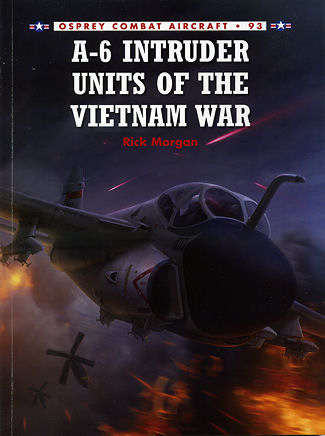 Number
93 in Osprey's Combat Aircraft series is on the A-6 Intruder and its role in the
Vietnam War. The A-6 was a result of the Navy's desire to have a 'medium attack'
aircraft to fit in between the light attack planes such as the A-4 Skyhawk and
the heavies such as the A-3 Skywarrior. It was required for the aircraft to be
able to operate at night and in somewhat inclement weather. Previously, these
sorts of operations were done by specialized units flying aircraft like the
AD-5N Skyraider.
Number
93 in Osprey's Combat Aircraft series is on the A-6 Intruder and its role in the
Vietnam War. The A-6 was a result of the Navy's desire to have a 'medium attack'
aircraft to fit in between the light attack planes such as the A-4 Skyhawk and
the heavies such as the A-3 Skywarrior. It was required for the aircraft to be
able to operate at night and in somewhat inclement weather. Previously, these
sorts of operations were done by specialized units flying aircraft like the
AD-5N Skyraider.
It was decided to have both the pilot and the weapons
system operator sit side by side in a rather wide cockpit and this turned out to
be a great way to provide good crew coordination, something that one doesn't get
with one guy sits behind the other as in today's two seat strike aircraft.
Anyway, Grumman got the contract for their A2F and as
often happens, a lot of new and untried equipment was part of the package. The
aircraft suffered through the usual teething troubles, most of it to do with the
bombing/navigation suite. Like the later F-111, the A-6 was designed to operate
at low level, over rough terrain, at night and in poor weather. The system,
developed by Litton eventually had the bugs worked out of it, but it took a
while and initial aircraft deliveries had a system that did not work as
advertised.
As the A-6 was entering into fleet service, the Vietnam
War was getting serious. The first unit to build up was VA-75, the Sunday
Punchers. They were also the first unit deployed to Vietnam for the first of
three war cruises. Things did not go exactly as planned as several aircraft were
lost. Some to flak, but some also to an issue with premature bomb detonations as
the bombs went off as soon as they were released. Not good. They were replaced
by VA-85 who had similar issues with premature detonation before the issue was
fixed once and for all. The record for war cruises was held by VA-196 with five.
Not surprisingly, most, though not all, A-6 fleet units saw combat in Vietnam.
The same goes for their Marine Corps brethren.
By the time of the end of the war in 1973, 17 per cent
of all A-6A/EA-6A production had been lost in combat. That totaled 84 aircraft.
Though not like the losses to the F-105 community, it was still significant as
the Navy did not fly as many sorties. The A-6A was replaced post war by the more
capable A-6E and many older airframes were upgraded.
Author Rick Morgan takes a look at the design and
development of the Intruder and the build up to get units on line for the war.
As you might expect, there are a lot of 'war stories' in this one as each unit
that was sent into combat is covered. As mentioned, the Marine involvement with
the Intruder is covered as well, including their operations of the EA-6A, a
version the Navy did not use during the war. The book is full of stats, great
photos and several pages of profiles.
In all, I found the book to be a superb read about an
aircraft that is often overlooked by both enthusiasts and modelers alike. Most highly recommended.
January 2013
For more on the complete line of Osprey books,
visit www.ospreypublishing.com
or contact them at Osprey Direct, PO Box 140, Wellingborough, Northants,
NN8 2FA, UK. In the US, it is
Osprey Direct at 44-02 23rd St, Suite 219, Long Island City, NY 11101., where you can
get a catalogue of available books.
If you would like your product reviewed fairly and quickly, please
contact
me or see other details in the
Note to
Contributors.
 Number
93 in Osprey's Combat Aircraft series is on the A-6 Intruder and its role in the
Vietnam War. The A-6 was a result of the Navy's desire to have a 'medium attack'
aircraft to fit in between the light attack planes such as the A-4 Skyhawk and
the heavies such as the A-3 Skywarrior. It was required for the aircraft to be
able to operate at night and in somewhat inclement weather. Previously, these
sorts of operations were done by specialized units flying aircraft like the
AD-5N Skyraider.
Number
93 in Osprey's Combat Aircraft series is on the A-6 Intruder and its role in the
Vietnam War. The A-6 was a result of the Navy's desire to have a 'medium attack'
aircraft to fit in between the light attack planes such as the A-4 Skyhawk and
the heavies such as the A-3 Skywarrior. It was required for the aircraft to be
able to operate at night and in somewhat inclement weather. Previously, these
sorts of operations were done by specialized units flying aircraft like the
AD-5N Skyraider.